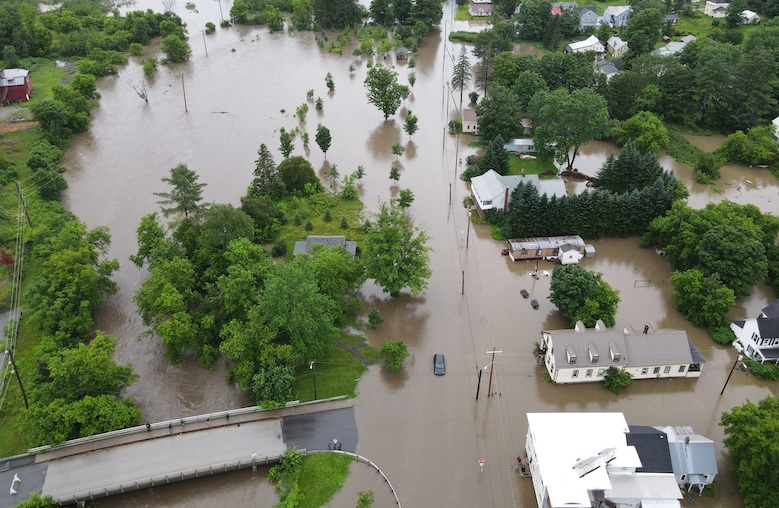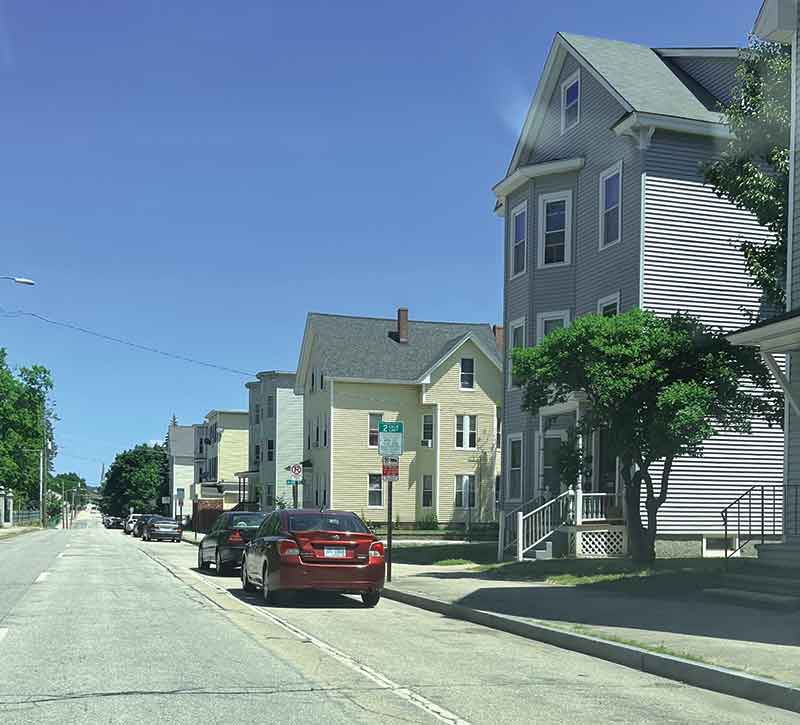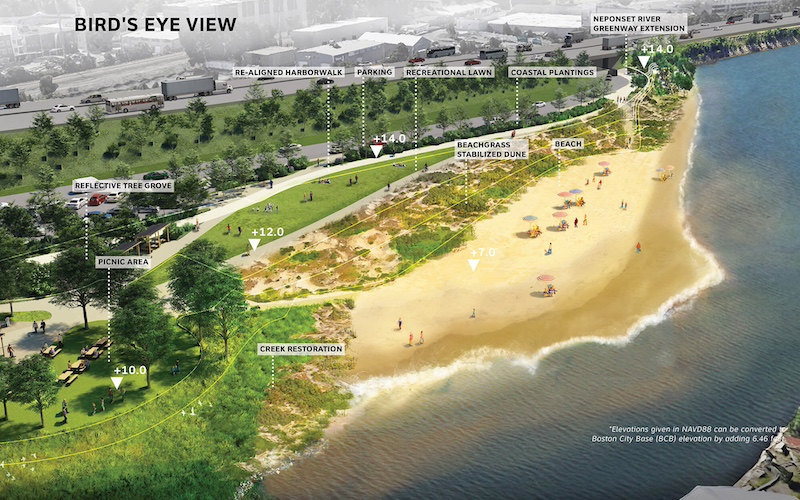After Tropical Storm Irene caused rivers to overflow their banks in 2011, sending floodwaters rushing into homes, town leaders in Northfield, Vermont, understood that something had to change.
So they made a dramatic move. With help from the Federal Emergency Management Agency and the State of Vermont, the town bought out 18 flooded houses adjacent to Dog River in Northfield’s Water Street neighborhood. With input from the community and help from Friends of the Winooski River, the town built a public park on a four-acre parcel of land. The idea was simple: if flooding should happen again, this time, the water would have a place to go other than people’s homes.
The summer of 2023 put the park to the test. Nine inches of rain fell across the state in 48 hours. And yes, Dog River Park flooded, as it was designed to do. But most importantly, homes in the Water Street neighborhood didn’t. Without the park, says Michele Braun, former land use planner for the town of Northfield and now executive director at Friends of Winooski River, water levels in the neighborhood would have stood six inches higher than they did. Many homes might have met the same fate as so many others destroyed by the rains in 2023. This time around, however, most Northfield houses received relatively minimal basement flooding, far different from the eight feet of water that gushed into homes after Tropical Storm Irene.
“The fact that they only had basement flooding is a win,” says Braun.

Common-sense Approaches to Climate Change
Northfield’s embrace of a natural solution to address devastating flooding reflects the commonsense climate approach underlying Act 121, Vermont’s Flood Safety Act. The legislature passed the law this past spring (with vigorous support from CLF and our partners) in response to 2023’s severe flooding. The law protects and enhances natural tools—wetlands, river corridors, forests, parks, and green spaces—that can efficiently and effectively absorb and redirect dangerous precipitation levels before floods sweep through towns.
The Flood Safety Act’s passage underscores an increasingly accepted principle for making communities more resilient in the face of the extreme storms, torrential rains, and searing heat waves triggered by climate change: lean into nature.
“Nature provides the most practical, affordable, and effective solutions to deal with the impacts of climate change,” says Julie Silverman, CLF’s Lake Champlain Lakekeeper. “We need to adjust to this new normal, and nature-based solutions can offer relief.”
What are “Nature-Based Solutions”?
According to Cynthia Pansing, CLF’s Interim Vice President for Healthy and Resilient Communities, “nature-based solutions rely on natural systems to solve environmental and community problems.” Those solutions can run the gamut, from “managed retreat,” as in the case of Northfield, where some flood-prone areas are relinquished to natural forces, to restoring wetlands to retrofitting our built environment to harness the power of nature. Reengineering culverts to allow for better water flow and wildlife passage, using living systems to tackle water quality problems, planting more trees to cool neighborhoods, designing living shorelines to help prevent beach and cliff erosion, installing rain gardens and green roofs to absorb stormwater runoff – all options are on the table.
“There are multiple benefits,” says Pansing. “Nature-based solutions can enhance the livability of communities while costing much less to implement. We can’t just build our way out of these climate change issues.”
Urban Forests Cools Things Down
While Vermont wrangles with more frequent and extreme storms, residents of Manchester, New Hampshire, stifle under another dangerous impact of our changing climate: suffocating heat waves. There, streets ironically named for trees – Chestnut, Elm, Pine, and Maple – offer stretches largely devoid of them. That leaves residents at risk. Without tree cover, infrastructure like roads and buildings absorb, rather than reflect, the sun’s heat. And that makes these neighborhoods deadly hot. “Trees not only provide shade – they also help to prevent chronic health issues such as asthma and heart disease, especially during heat waves,” says Arnold Mikolo, CLF’s environmental justice advocate in New Hampshire.
It’s no coincidence that people living with the least tree cover in Manchester – and nationwide – have lower incomes and tend to be people of color and immigrants who speak limited English. Last year, Mikolo partnered with The Nature Conservancy and city officials to secure a $2.2 million grant from the federal Forest Service’s Urban and Community Forestry Program. The grant will allow the city to undertake a major initiative to boost its urban forest by planting and maintaining trees in its lower-income neighborhoods.
With an additional focus on workforce development, “this initiative promises to transform the quality of life for residents and enhance the city’s ecological and economic sustainability for years to come,” says Mikolo.

Lowering the Temperature in Hot Neighborhoods
Similar efforts to bolster urban forests are underway in other disadvantaged neighborhoods across New England, many funded by money allocated by the 2023 Inflation Reduction Act. By strategically planting trees to provide shade and reduce heat island effects, cities and towns across the region will be cooler and safer places to live.
Meanwhile, as many towns and cities take a second look at trees, coastal areas are rethinking how nature-based solutions might reduce tidal flooding and shoreline erosion. In Massachusetts, CLF is pushing to streamline the permitting process for such projects. Many run into trouble because they seem to contradict existing regulations aimed at protecting shoreline ecosystems and habitats. But with climate change, the old rules and procedures need critical updates to adjust to new realities.
The city of Boston has laid out its own ambitious climate plan involving re-tooling 47 miles of coastline to cope with rising seas, flooding, and extreme storms. The plan, called Climate Ready Boston, calls for planting coastal parks, rain gardens, and dunescapes, as well as roads and parks that can function as levees. CLF supports this effort but is calling for more transparency in prioritizing and implementing the plan’s nature-based approaches to ensure resources are equitably distributed throughout the city.

Growing Our Wetlands
Back in Vermont, the increasing pace and fury of climate-driven storms has led not only to the passage of the Flood Safety Act and Climate Superfund Act but to a cultural shift. That shift involves recognizing that the effects of climate change are here to stay, so we must use the tools at hand – nature – to fight back. That shift in thinking has already resulted in hundreds of wetlands getting restored, flood plains being bought out, and many dams being removed over the last 10 years. The new Flood Safety Act will accelerate that kind of critical restoration.
CLF’s Silverman has helped to bolster this new way of thinking born of the flood devastation she has witnessed firsthand.
“It’s an understanding that nature does a much better job managing intense rainfall and flooding than we ever could,” she says. “We could try to engineer our way out of this, but nature already has all the solutions. Mother Nature knows how to take care of the rain.”
